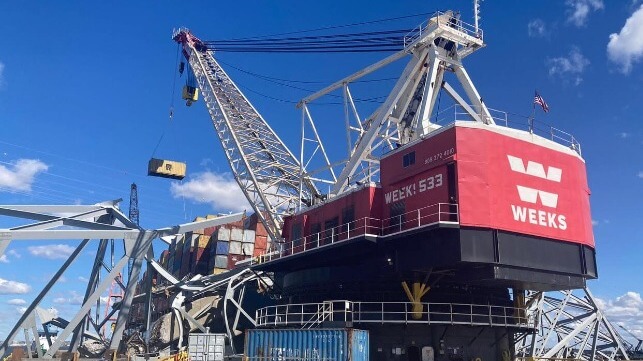East Coast Container Rates Are Getting Cheaper Despite Baltimore Shutdown

As predicted by many shipping analysts, the shutdown of the Port of Baltimore has not significantly affected container rates to the U.S. East Coast, and other nearby seaports have had adequate handling capacity to pick up the slack. Far from a pandemic-like price spike, the rates on core Asia-USEC routes have actually declined since Baltimore's inner harbor shut down, according to freight intelligence firm Xeneta.
On March 26, the boxship Dali struck a pier on the Francis Scott Key Bridge, collapsing the through-truss span and killing six road workers. The wreckage closed the harbor to deep-draft traffic, including container ships. All terminals are shut to water-side commerce, with the exception of Tradepoint Atlantic, a ro/ro and breakbulk port located seaward of the bridge.
After the collapse, multiple public officials warned of national economic disruption from the shutdown of the harbor. While the local effects are serious - thousands of Baltimore longshoremen are out of work - and shippers with diverted containers have to pay more for trucking, there appears to be no systemic effect on freight transport to and from the East Coast, based on Xeneta's data.
"Spot rates have not reacted but that doesn’t mean shippers with cargo heading to Baltimore are not affected – on the contrary they are seeing containers arriving at ports they were not expecting," said Xeneta chief analyst Peter Sand. “The majority of containers will now be handled at New York / New Jersey because many of the ships originally bound for Baltimore would have been stopping there anyway, which is perhaps why we haven’t seen an upwards impact on rates."
Spot rates from the Far East to the U.S. Northeast are down by about one percent since the bridge collapsed, according to Xeneta, and are running at $5,400 per forty-foot box. (This is approximately half of the late-pandemic peak.) From Europe to the U.S. Northeast, spot rates are down eight percent.
The changes in container rates are unrelated to any changes in pricing for ro/ro shippers. The Port of Baltimore is the busiest hub for shipping autos and rolling equipment in the United States, and these ro/ro cargoes have no direct connection to containerized freight.
The U.S. Army Corps of Engineers is working on reopening Baltimore's shipping channel, with support from commercial contractors and the U.S. Navy Supervisor of Diving and Salvage. USACE's objective is to clear a 35-foot-deep channel for ro/ro traffic by the end of the month, and fully clear the 50-foot channel for deep sea shipping by the end of May. The reconstruction of the bridge will take far longer, and a political debate is well underway on how to fund it.
2024 is Set to be a Year of Supply Chain Disruption on U.S. East Coast

[By: Xeneta]
The collapse of the Francis Scott Key Bridge in Baltimore has caused supply chain disruption on the US East Coast but, so far, it has not seen an increase in ocean freight container shipping rates.
Data released today, Monday, by Xeneta, the ocean freight rate benchmarking and intelligence platform, reveals average spot rates from the Far East into the US North East Coast (including Baltimore) have fallen slightly (-1%) since the bridge collapse on 26 March to stand at USD 5421 per FEU (40ft shipping container).
When including other US East Coast ports such as New York / New Jersey, rates from the Far East have decreased by 3% in the same period.
Average spot rates from North Europe to the US North East Coast have fallen by a larger 8% in the same period to stand at USD 2357 per FEU. When including other US East Coast ports, rates have decreased by 4%.
Peter Sand, Xeneta Chief Analyst, said: “Spot rates have not reacted but that doesn’t mean shippers with cargo heading to Baltimore are not affected – on the contrary they are seeing containers arriving at ports they were not expecting.
“The majority of containers will now be handled at New York / New Jersey because many of the ships originally bound for Baltimore would have been stopping there anyway, which is perhaps why we haven’t seen an upwards impact on rates.
“Ocean freight container shipping rates may not have increased following the bridge collapse, but this incident is yet another problem for shippers to handle on top of all the other disruptions impacting supply chains at the moment, including the ongoing diversions in the Red Sea region and drought in the Panama Canal.”
On Friday, 5 April, the Port of Baltimore issued an update stating it expects to open a 280-feet wide and 35-feet deep federal navigation channel by the end of April, followed by a reopening of the permanent 700-feet wide and 50-feet deep channel by the end of May, restoring port access to normal capacity.
While shippers will welcome a timeline for the reopening of maritime lanes into Baltimore, Sand believes importers into the US East Coast could be set for further disruptions in 2024 due to labor negotiations.
The International Longshoremen’s Association’s six-year contract with the United States Maritime Alliance, which represents port terminal operators and ocean carriers on the East Coast, expires on 31 September – and no new agreement has yet been reached.
Sand said: “The threat of labor strikes on the East Coast has the potential to cause far more disruption to ocean freight shipping than the collapse of the Francis Scott Key Bridge.
“The clock is ticking and if no agreement is reached then the implications will be significant and widespread disruption at US East Coast ports. This would almost certainly see rates increase for ocean freight container services and could see some shippers choosing to head back to the US West Coats or Mexico for imports.”
The products and services herein described in this press release are not endorsed by The Maritime Executive.
No comments:
Post a Comment